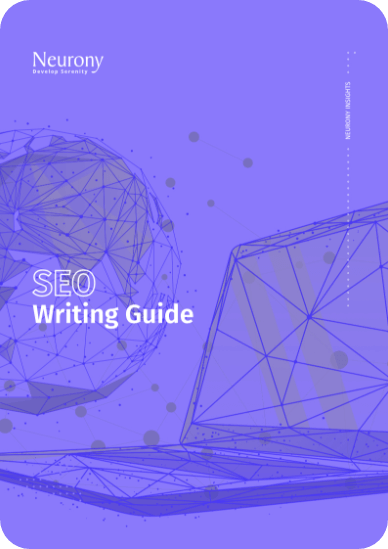Summary
Despite the constant changes in the SEO landscape, the principles of SEO remain the same:
- EASE OF ACCESS;
- COMPREHENSIBILITY;
- RELEVANCE.
Search engines rely on their Spiders/ Crawlers/ Bots to gather information and organise it – the main purpose of SEO is to make websites more appealing to said bots. However, SEO should be user-centric; thus, websites should not be structured and written more for machines than for people. Instead, SEO should be melded with UX.
In a nutshell, the steps contained in this document are as follows:
Step 1. All content that should rank high should be discoverable within 3 clicks from any page on the website. The content should go from general to particular and the URLs should follow this structure:
https://www.domain.com/string1/string2/.
Step 2. Make good use of all the meta elements, as they have the power to drive traffic to the website:
- Page titles – A good title is clear, concise and topically relevant. Write for humans first, optimise for machines second.
- Meta descriptions – They should be as descriptive as they are intriguing, and should immediately grab the attention of the user.
- H1 & H2 tags – The H tags are similar in nature to the Title tag.
- Body Copy – Write unique content. Use synonyms for the main keyword, as well as contextually-relevant keywords.
- Images and Rich-media – Use alt- attributes describing the content of the media.
Step 3. Context – One of the golden rules of
SEO is to have one page optimised for one
keyword per domain, so multiple pages of
the same website don’t end up competing
against each other.
Internal Folder Structure
A good website groups its pages in a way that’s easy to understand and logical – usually from the General to the Particular. The more particular a page, the more niched, the less relevant it becomes to the general audience.
For example, for this URL:
https://www.domain.com/string1/string2/
a. https://www.domain.com/ is the root – this is as general as it gets and it most likely has relevant information for a good part of the user base;
b. /string1/ – gets more specific These pages should include some body copy (2-300 words), not just links to more in-depth pages. They can also serve as a default 301 target for defunct subpages;
c. /string2/ – only relevant to people interested in a very specific topic that falls under the category defined by /string1/, so it will be deemed less important to the general public by crawlers.
To simplify – all content that should rank high should be discoverable within 3 clicks from any page on the
website. This is of course not set in stone, but a sensible rule of thumb.
2. Page Structure and Content
This can get rather technical, so we’ll only focus on the most important bits:
Elements that show up on the search engine results pages:
- MetaDescription
- Page Title
Elements visible to the viewer of the page itself:
- H1 tags
- H2 tags
- Body copy
- Multimedia content (images, videos, pdfs)
The Title and the MetaDescription tags serve two purposes:
- They tell crawlers what a page is about;
- They act as advertisements when viewed on the SERP (driving clicks and traffic).
What makes a good page title?
To understand how page titles should be written is to understand how search engines treat keywords. There are two main types of keywords – long-tail and short-tail
(generic). For instance, “funds” is the generic term, whereas “alternative investment funds” is the long-tail. Note that the longer search phrase includes the
generic term – this in turn translates into long-tail keywords also ranking for generic/broad searches. However, they are highly specific so more likely to match user-intent.
Multiple long-tail search phrases can be grouped under a single topic, which is usually the broad term. Building a list of possible long-tails based on a list of topics is recommended when planning to rank high for those topics.
Going back to the original question, there
are several things that make a good page
title:
- It should begin with the main keyword (as specific as possible);
- It should be shorter than 50-60 characters (it can be longer, but anything beyond the 60-character mark will not be displayed on the SERPs);
- It must be relevant to and consistent with the information presented on the page;
- It can contain a hook – a date, a question or a call to action;
- It shouldn’t match the H1 title perfectly (they could be variations of the same thing).
A good title is clear, concise and topically relevant. Write for humans first, optimise for machines second.
Say, for instance, the main keyword is “alternative investment funds”. Here’s an example:
Alternative Investment Funds – Luxembourg, an internationally recognised location for alternative
investments
As a side-note – the URI should closely match the page’s title or H1 tag (use the same words, with hyphens between them; prepositions can be dropped). To clarify,
this is the URL:
https://www.domain.com/string1/string2/
and this is the URI: /string1/string2/.
Wherever possible, the words in the URI should be the ones in your Title. As per our example above, the URI would be: /investments-funds/alternative-investment-
funds/.
Meta-description – your most affordable ad-space
Meta-descriptions used to positively influence SERP rankings, but not anymore. However, they do influence one critical thing – your click-through-rate. As long as it
is kept below 160 characters (and thus can be displayed in-full on SERPs), it can act as
a small ad for your page, telling your potential visitor whether the page is relevant to them or not. It should be as descriptive as it is intriguing, and should immediately grab the attention.
You do not have to use any keywords when writing it, but it can help.
Body Copy – the gist of the matter
- Here is what good body copy looks like:
- It is unique to that page (it does not copy more than 20% of its contents from another page);
- The page’s main keyword can be found among its first 100 words;
- It is at least 500 words long;
- It links out to other pages where appropriate;
- It contains synonyms for the main keyword, as well as contextually-relevant keywords;
- It alternates short and long sentences and phrases for easy reading;
- It can and should be split into sections by H2 titles.
Body Copy – the gist of the matter
Rich media refers to video, audio or any other type of content that users can interact with. SEO-wise, there are 4 rules to follow when it comes to images and rich-media:
- Make sure that each of your images have alt-attributes that describe what the image is about. Search engines cannot see images and therefore cannot “read” them. As such, it is necessary to specify the content of an image so that search engines know what it represents. Having alt attributes for images will help your page rank higher in SERPs. This also helps with visually impaired users or those that have disabled images in their browsers.
- Use it whenever possible (it keeps users interested for longer which in turn lowers bounce rates and this sends positive relevance signals to Google).
- Make sure it complements the text rather than replace it (transcripts are welcome too – Google can’t fully understand or crawl videos just yet).
When naming your files, make sure they’re easily discoverable online. Here are some formatting alternatives:- PageTitle+FileDescription+FileNumber;
- MainPageKeyword+FileDescription;
- MainPageKeyword+FileID.
3. Context
At any given point in time, multiple pages are competing for the same keyword and position. More importantly, they do not have to belong to different websites. Pages on the same domain, if optimised for the same keyword, will fight for the same place on the SERP. One of the golden rules of SEO is to have one page optimised for one keyword per domain.
Context is also important when building the backlink strategy- a specific article would benefit a lot more from another specific article, than from the homepage of the linked domain.





